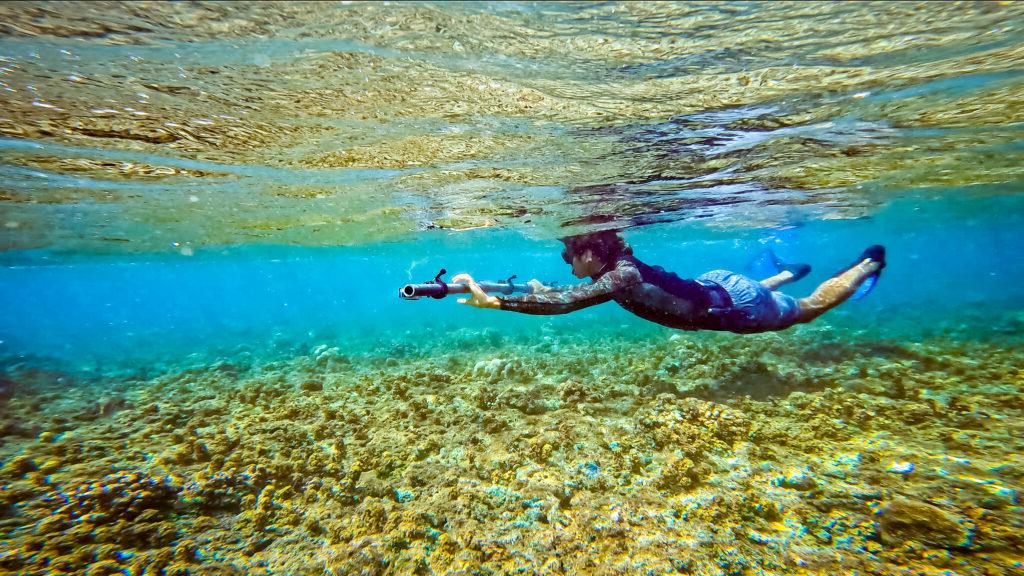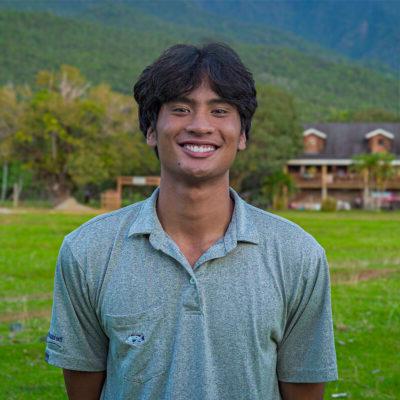 Sammy Basa ’25 surveying the reefs in Sibuyan Island
Sammy Basa ’25 surveying the reefs in Sibuyan Island
Sammy Basa ’25 traced his love for the ocean to a boat ride under a starry canopy to Sibuyan Island. Basa recalled how the brisk wind cooled his face and how he and his mother dipped their feet into water that glowed with bioluminescence.
“The bright flashes of blue and green were like stars in the sea, and we watched in wonder as they faded into the darkness,” said Basa. “While those flashes appeared as pure magic to my younger self, they signified something profound—a deep-seated bond between my family, our land, and the marvels of the natural world.”
Basa’s family hails from Sibuyan Island in the Philippines, and Basa has many childhood memories from his grandfather’s farm. Sibuyan is called the Galápagos of Asia for its biodiversity. However, underneath the emerald forests is a saddening ecological reality: coral reefs devastated by dynamite fishing and climate change.
Nature’s unsung heroes
About 25 percent of marine species depend on coral reefs according to the book Life in the World’s Oceans. Resource Watch estimates that 1 billion people benefit from reefs’ ecosystem services, including food and protection of coastlines from storms and erosion. A Nature article found that reefs reduce wave energy by an average of 97 percent.
Sibuyan resides in the Coral Triangle region, which hosts 30 percent of the world’s reefs according to a 2020 report on Earth.Org. Despite this reality, Basa noticed a gap in reef monitoring in Sibuyan and sought to rectify it.
 Sammy Basa ’25
Sammy Basa ’25
Basa, who studies environmental science at Pitzer, did an independent study in fall 2023 with Visiting Assistant Professor Suryatapa Ghosh Jha as his adviser. He delved into scientific literature and 3D mapping techniques to prepare to collect data in Sibuyan, where his family had planned a visit during winter break.
Basa faced challenges while applying for institutional funding at the 5Cs, but he decided to proceed with his own limited budget. Once he arrived in Sibuyan, the local community embraced him thanks to his grandfather’s legacy.
“My lolo [grandfather in Tagalog] was an environmentalist and did a lot for the island,” said Basa. “He took care of people. That’s why they helped me.”
Documenting coral reef health
Community members drove Basa and his team out on boats to survey shallow reefs. Basa used photogrammetry, in which multiple cameras take thousands of pictures to create 2D and 3D photomosaics.
Basa’s goal is to help make a baseline coral health assessment for the San Fernando Local Government Unit (LGU) in the Philippines. Although Basa is still processing the data, he immediately noticed an algae issue.
“Lack of fish and runoff have led to a big bloom of algae,” said Basa. “Coral can’t survive when there’s overfishing, but at the same time people have to eat.”
This issue is also related to dynamite fishing, which uses explosives to stun or kill fish. Although the practice is banned, Basa heard booms while he was diving underwater.
Integrating science and local communities
“You can’t just tell people not to make a living, especially when they’re impoverished,” said Basa. “You can’t expect marine sanctuaries to work if people don’t understand their value and what they can do in 10 years.”
The complexities of marine conservation, food, and society have strengthened Basa’s passion for community-driven scientific research and education.
“It gives a deeper meaning to your research when you’re working with the community,” said Basa. “The people have valuable insights on the future of their home. They are the ones who will take care of that place.”
 Photo courtesy of Sammy Basa ’25
Photo courtesy of Sammy Basa ’25
Basa seeks to add his data to the Romblon State University’s assessment of the island’s reefs. He hopes his findings will aid the San Fernando LGU to garner national support and apply for funding for reef intervention.
“Community-based science is arguably the most effective way to get things done with marine life and coral conservation,” said Basa.
Basa is working on his data while he studies abroad in Pitzer in Costa Rica this spring. He has also applied for funding to return to Sibuyan and do more research and local engagement. He credits his family, friends, and mentors for their support to make the project possible.
“My family gave me the opportunity to learn how amazing the world is at such a young age,” said Basa. “I want to keep places like Sibuyan alive and well and allow other people to have those experiences too.”